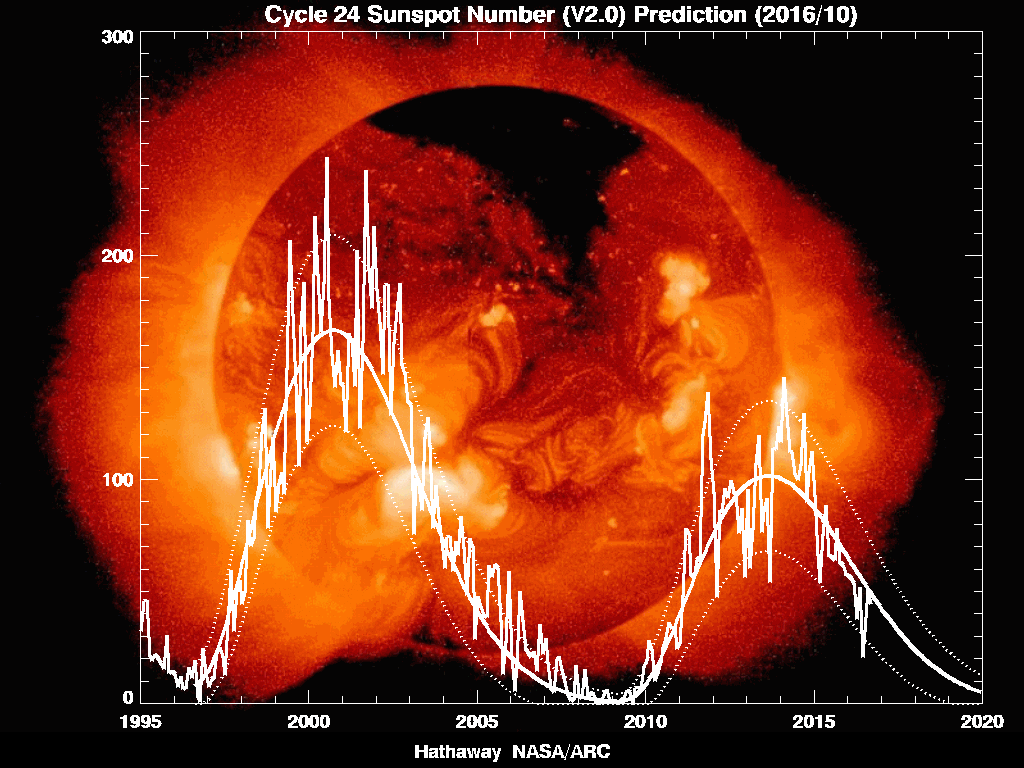|
|
Post by breakingitdown on Jan 1, 2011 1:58:37 GMT
|
|
|
|
Post by lsvalgaard on Jan 1, 2011 7:19:18 GMT
The sun moves so slowly through the interstellar medium that one would not expect variations on the time scale of the solar cycle. |
|
|
|
Post by af4ex on Jan 1, 2011 14:52:35 GMT
Starting the new year off with increased solar activity. It has ramped up considerably since last week: SFI in the 90's and Xray background back up to B1+. NOAA only lists two active regions with spots, 1138&1140, (green circles) and two active plages, 1137&1139 (green boxes). But I think I see a couple that NOAA/USAF missed, seen below in microwaves (yellow) but also coincide with activity in magnetograms. Is SC24 transitioning into a new phase, on its way to SFI > 100? Attachments:
|
|
|
|
Post by af4ex on Jan 1, 2011 17:07:25 GMT
Below is a plot of the major activity indices (SN, SFI, 304A etc) which shows the solar activity kicking up over the last few days of December. Before that was a two-week quiet period (white box), which began, perhaps not coincidentally, when AR1131 went 'far side' and ended approximately when it rotated back into Earth view as "AR1140" a few days ago. Now AR1140 has several helpers in keeping the activity levels high again. Attachments:
|
|
|
|
Post by af4ex on Jan 2, 2011 13:47:45 GMT
The new regions noted yesterday have numbers now: 1141 and 1142 and are visible in microwaves. Especially 1142, which radiated moderately bright for several hours this morning. Its microwave image spot is more homogenously broad, but not as bright as former AR1131 (now AR114) which shined continously bright on the previous rotation. (Of course, optically, AR1140 is much larger than AR1142, and its microwave emissions are scattered from a larger area) All of this microwave activity is taking place in the atmosphere above the photospheric spots. The microwave radiation (at 17Ghz) is generated by charged particles gyrating along the magnetic loops extending into the chromosphere above the active regions. Attachments:
|
|
|
|
Post by af4ex on Jan 3, 2011 12:34:04 GMT
A small bright spot was visible in AR1140 last night. Oscillated between bright and dim for 8 hours while in the view of Nobeyama. Would be interesting to overlay this with the visible continuum to see what part of AR1140's huge sunspot area was emitting these microwave pulsations. Attachments:
|
|
|
|
Post by af4ex on Jan 3, 2011 16:49:21 GMT
|
|
|
|
Post by Pooh on Jan 4, 2011 5:41:29 GMT
Ooops! This just in. Hathaway/NASA/MSFC Cycle 24 Sunspot Number Prediction (January 2011)  It is much too soon to tell It is much too soon to tell, but it looks like it is aiming at Lief's peak rather than Hathaway's. |
|
|
|
Post by jcarels on Jan 4, 2011 10:14:52 GMT
I didn't forget the eclipse  . Here's a picture I took this morning. Seeing conditions were terrible. Attachments:
|
|
|
|
Post by jcarels on Jan 4, 2011 12:30:53 GMT
and another picture: Attachments:
|
|
|
|
Post by af4ex on Jan 4, 2011 23:04:04 GMT
jcarels> Seeing conditions were terrible. Apparently so for most observers: Wikipedia has updated their 4Jan11 eclipse page with more photos: en.wikipedia.org/wiki/Solar_eclipse_of_January_4,_2011 I am hoping the Nancay radioheliograph was operational this morning during the eclipse. Perhaps they will post the results soon and we'll get a glimpse of the eclipse in VHF/UHF imagery. (it will be somewhat 'smudgy' because of the long exposures, but interesting to see) bass2000.obspm.fr/home.phpFor comparison purposes (hopefully), here are the Nancay heliographs from 3 Jan: Attachments:
|
|
|
|
Post by af4ex on Jan 5, 2011 1:11:05 GMT
We've had a bunch of B flares and one C flare each for 1141 and 1142, this morning and yesterday, Now a mid-size B flare from 1140, not reported yet by NOAA/USAF, about an hour ago, 4Jan2011 at approx 2350Z [Edit: NOAA finally classified this event as a B4.2 Xray flare: 2990 2339 2345 2351 G15 5 XRA 1-8A B4.2 2.1E-04 1140 ]  Attachments:
|
|
|
|
Post by af4ex on Jan 5, 2011 18:01:22 GMT
The movies of the Nancay radio heliograph for 4 Jan have not been posted yet. But they do have optical movies of the partially eclipsed Sun filtered in Ha and CaIIK for public download. bass2000.obspm.fr/home.php?end=1294163889Heavily obscured by clouds and jitter, but interesting. Attachments:
|
|
|
|
Post by jcarels on Jan 5, 2011 19:36:31 GMT
|
|
|
|
Post by af4ex on Jan 5, 2011 20:19:46 GMT
jcarels> Here's an eclipse movie from Proba2/Swap: Actually two eclipses 1) partial solar eclipse as Moon passes in front of Sun, followed by 2) total eclipse ('sunset') as Proba2 passes into Earth's shadow! Very nice imagery. I have added Proba2 to my list of solar data resources. The SWAP EUV imager does a fantastic job of rendering the magnetic lines. Is "174" the wavelength in Angstroms? Tnx
|
|